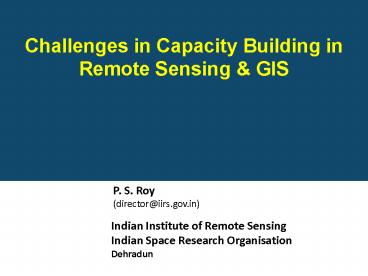Challenges in Capacity Building in Remote Sensing - PowerPoint PPT Presentation
Title:
Challenges in Capacity Building in Remote Sensing
Description:
Beginning of Career Achieving ... Proper planning is needed to over- come this issue Know-how in modern day technology and hand ... seismic & geodynamic ... – PowerPoint PPT presentation
Number of Views:111
Avg rating:3.0/5.0
Title: Challenges in Capacity Building in Remote Sensing
1
Challenges in Capacity Building in Remote Sensing
GIS
P. S. Roy (director_at_iirs.gov.in)
Indian Institute of Remote Sensing Indian Space
Research Organisation Dehradun
2
Challenges in Capacity Building in Remote Sensing
GIS
- The UNCED (1992) definition for capacity building
encompasses scientific, technological,
organizational, and institutional resources and
capabilities. - A fundamental goal of capacity building is to
enhance the abilities of stakeholders to evaluate
and address crucial questions related to policy
choices and modes of implementation among
different options for development.
Capacity building Process
Achieving Excellence
Beginning of Career
3
Capacity Building Initiatives
- Capacity building efforts can be designed to
serve individuals, organizations, geographical or
interest communities, or the nonprofit sector as
a whole. - Direct response programs which provide funds or
services to nonprofits to address defined
capacity building needs. - Capacity building initiatives which target a
select group of nonprofits and usually address a
broad range of organizational effectiveness
issues. - Sector-strengthening programs which support
knowledge development, knowledge delivery, or
knowledge exchange. - Building a better knowledge base about the impact
of capacity building requires a methodology that
allows comparison across different types of
capacity building engagements and programs.
4
Curriculum, Infrastructure Tools Issues
- Obsolete/Rigid Curricula and delivery mechanism
- Absence of uniform academic standard and lack of
networking - Difficulty of releasing many officers for
long-term training even when majority require
retraining to update their knowledge in the
emerging new technologies - Lack of financial resources for international
exposures - Lack of provision for continuing education and
training
- State-of-the-art laboratories, field instruments
and trained faculty - Uniform academic standard and proper networking
would have facilitated sharing of human and other
training facilities - Survey organizations have not inducted
professionalism and there is wide gap in
adaptation of contemporary technology.
Introduction of modular curricula will enable
interested persons to join short module(s) of
interest and then go back to their jobs. - Proper planning is needed to over- come this
issue - Know-how in modern day technology and hand
holding with current trend is required for
excellence in capacity building exercise.
5
Earth Observation A Spectrum of Environmental
Applications
6
Challenges of Capacity Building in Remote Sensing
and GIS
- Satellite remote sensing exits for three decades
with variety of data sets and its prudent
application for well being of human society. - Geographical Information System in present form
is two decade old and encompasses its role in all
sectors of daily life. - Technological know-how to these areas is very
much important for wider application in grass
root level.
7
Challenges of Capacity Building in Remote Sensing
and GIS
- Curriculum Development
- It needs to be very dynamic in nature to tune
with the rapidly changing technology. - Remote Sensing is multi-disciplinary in nature
because of its varied applications domain.
Curriculum needs to allow for specialization in
specific areas as per the users need. - The target group should be i) Young fresh
graduates who wants to make carrier in remote
sensing ii) people who are at the beginning of
their professional carrier iii) Middle level
professionals and finally iv) the decision
makers. This will allow the flow of knowledge to
all levels of personnel in a particular domain.
8
Challenges of Capacity Building in Remote Sensing
and GIS
- Research in Curriculum
- Innovation in technology to improve understanding
of the relevant processes and their interactions
and identify the various impacts and changes - Calibration and validation issues
- End to-end research from data generation to data
modeling. Other areas to include in the capacity
building are the operation of ground stations for
tracking and telemetry and command, satellite
data applications, acquisition and processing of
satellite data from various satellites - Impromptu response when natural calamity struck.
Capacity building activity is indispensible so
that data can be processed quickly for immediate
response to the disaster event. - Building of capacity for transfer of knowledge,
skills and technology and promote the exchange of
experiences.
9
Challenges of Capacity Building in Remote Sensing
and GIS
- Continuum Education
- Because of the fast changing technology in remote
sensing and GIS, the trainees used to out of
date quickly. There has to be provision of
bringing them back after every five years and
appraised them with the newer technology. - This refreshers course should be of short
duration with focused theme. - Lecturers also need to maintain dynamic
curriculum to cater the present need and address
with the state-of-the-art technology.
10
Challenges of Capacity Building in Remote Sensing
and GIS
- Cutting Edge Technology
- Curriculum should address the newer scientific
arena e.g. Atmospheric remote sensing, climate
change issues, Ocean state forecasting, seismic
geodynamic phenomena etc. - Emphasis should be on the technology domain too.
State-of-the-art technology can only provide the
solution we are looking for. - It is highly essential to be acquainted with the
modern day technology current trends and
incorporate them into the curriculum.
11
Integrate What We Know
We Need Better Ways to
- Represent
- Understand
- patterns,
- relations,
- processes
- Manage
- Communicate
12
Thank you..
www.iirs.gov.in































